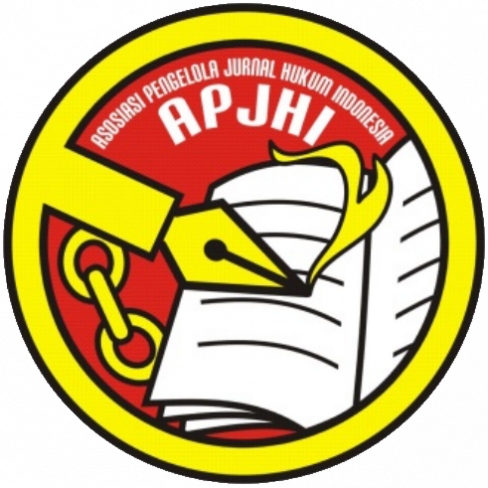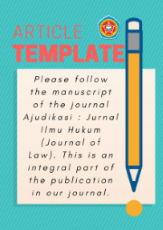Perlindungan Hukum Seni Batik Karawang Ditinjau Melalui Undang-Undang Nomor 28 Tahun 2014 Tentang Hak Cipta
DOI:
https://doi.org/10.30656/ajudikasi.v4i2.2747Abstract
This writing aims to find out how the development of batik in Karawang Regency as well as legal protection of the batik copyright typical of Karawang Regency with the provisions contained in Law Number 28 of 2014 concerning Copyright. Batik art is a technique of drawing on cloth and utilizing wax and canting as materials and tools to make it, batik is one of the works of art that requires high intellectuality in its creation. Legal protection of batik copyright is needed to avoid things that will be detrimental to the creator and copyright holder. The approach method used in this research is juridical empirical, which is research based on legislation and also using research based on facts, realities and problems in the field. The empirical juridical approach is a study that examines legal regulations, namely Law Number 28 of 2014 concerning Copyright, which is then linked with data from research research on batik typical of Karawang Regency.
Keywords: Protection; Copyright; Batik; Art.
Downloads
References
Buku :
Atsar, Abdul. Mengenal Lebih Dekat Hukum Hak Kekayaan Intelektual. Yogyakarta: deepublish. 2019.
Hasan, Iqbal. Metode Penelitian Hukum dan Aplikasinya. Bandung: Remaja. 2002.
Hidayah, Khorul. Hukum HKI: Hak Kekayaan Intelektual. Malang: Setara Press. 2017.
Khairandy, Ridwan. Pengantar Hukum Dagang. Yogyakarta: UII Press. 2006
Linsey, Tim. et,all. Hak Kekayaan Intelektual: Suatu Pengantar. Bandung: PT. Alumni. 2013.
Soekanto, Soerjono. Pengantar Penelitian Hukum. Jakarta: Universitas Indonesia. 2006.
Jurnal
Andhini, Alycia Sandra Dina, and Ridwan Arifin. “Analisis Perlindungan Hukum Terhadap Tindak Kekerasan Pada Anak Di Indonesia.†Ajudikasi : Jurnal Ilmu Hukum Vol. 3, No. 1 (2019): 41–52. https://doi.org/10.30656/ajudikasi.v3i1.992.
Fuqoha, Fuqoha, Indrianti Azhar Firdausi, and Arga Eka Sanjaya. “Perlindungan Hukum Terhadap Intervensi Pemberitaan Dalam Kerangka Kemerdekaan Pers Nasional.†Ajudikasi : Jurnal Ilmu Hukum Vol. 3, No. 1 (2019): 75. https://doi.org/10.30656/ajudikasi.v3i1.1436.
Iskandar dan Eny Kustiyah. “Batik Sebagai Identitas Kultural Bangsa Indonesia Di Era Globalisasiâ€. Jurnal Gema. Volume 52. Agustus 2016-Januari 2017.
Kusumaningtyas, Rindia Fanny. “Perlindungan Hak Cipta Atas Motif Batik Sebagai Warisan Budaya Bangsaâ€. Jurnal Online. Januari 2014.
Mastur dan Siti Khotimah. “Perlindungan Hak Cipta Motif Batik Lasem Dalam Undang- Undang Nomor 28 Tahun 2014â€. Jurnal Ilmiah Ilmu Hukum QISTIE. Volume 12 Nomor 2. November 2019.
Rahayu, Devi. “Perlindungan Hukum Terhadap Hak Cipta Motif Batik Tanjungbumi Maduraâ€. Jurnal Mimbar Hukum. Volume 23 Nomor 1. Februari 2011.
Sulasno dan Mia Mukaromah. “Perlindungan Hukum Terhadap Hak Cipta atas Batik di Kota Serang Provinsi Bantenâ€. Ajudikasi: Jurnal Ilmu Hukum. Volume 3 Nomor 2. Desember 2019.
Trixie, Alicia Amaris. “Filosofi Motif Batik Identitas Bangsa Indonesiaâ€. Jurnal Folio. Volume 1 Nomor 1. Februari 2020.
Peraturan Perundang-undangan
Indonesia, Undang-Undang Nomor 28 Tahun 2014 tentang Hak Cipta
Naskah Internet/Website
Dedi Satria, “Batik Taza Khas Karawang, Kedepankan Motif Kearifan Lokalâ€, dalam Naskah Online/Website (Oktober 2019), https://www.pasundanekspress. co/jabar/karawang/batik-taza- khas-karawang-kedepankan- motif-kearifan-lokal/ (diakses pada tanggal 15 November 2020 pukul 15.00 WIB).
Sabrina Santi, “Sejarah Batik Karawangâ€, dalam Naskah Online/Website (April, 2018), https://infobatik.id/sejarah-batik-karawang/. (diakses pada tanggal 15 November 2020, pukul 09. 13 WIB).
Downloads
Published
Issue
Section
License
Authors who publish with this journal agree to the following terms:
Authors retain copyright and grant the journal right of first publication with the work simultaneously licensed under a Creative Commons Attribution License that allows others to share the work with an acknowledgment of the work's authorship and initial publication in this journal.
Authors can enter into separate, additional contractual arrangements for the non-exclusive distribution of the journal's published version of the work (e.g., post it to an institutional repository or publish it in a book) with an acknowledgment of its initial publication in this journal.
Authors are permitted and encouraged to post their work online (e.g., in institutional repositories or on their website) before and during the submission process, as it can lead to productive exchanges and earlier and greater citation of published work.
All articles in Ajudikasi : Jurnal Ilmu Hukum can be disseminated provided they include the identity of the article and the source of the article (Ajudikasi : Jurnal Ilmu Hukum). The publisher is not responsible for the contents of the article. The content of the article is the sole responsibility of the author
Ajudikasi : Jurnal Ilmu Hukum is lincensed under a Creative Commons Attribution-ShareAlike 4.0 International License.










1.png)
.png)
.png)





.png)
.png)
.png)
.png)





.png)







